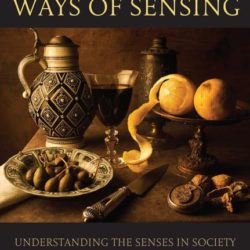
David Howes and Constance Classen
2014
Ways of Sensing is a stimulating exploration of the cultural, historical and political dimensions of the world of the senses. The book spans a wide range of settings and makes comparisons between different cultures and epochs, revealing the power and diversity of sensory expressions across time and space. The chapters reflect on topics such as the tactile appeal of medieval art, the healing power of Navajo sand paintings, the aesthetic blight of the modern hospital, the role of the senses in the courtroom, and the branding of sensations in the marketplace. Howes and Classen further consider how political issues such as nationalism, gender equality and the treatment of minority groups are shaped by sensory practices and metaphors. They also reveal how the phenomenon of synaesthesia, or mingling of the senses, can be seen as not simply a neurological condition but a vital cultural mode of creating social and cosmic interconnections. Written by leading scholars in the field, Ways of Sensing provides readers with a valuable and engaging introduction to the life of the senses in society.
Chapter Descriptions
Chapter 1. Mixed Messages: Engaging the Senses in Art
In the West, art is, above all, visual. This single-sensed understanding of art, however, has not gone unchallenged. Non-Western and Indigenous aesthetic practices such as the Japanese tea ceremony and Navajo sandpainting, reveal art forms which engage multiple senses. Contemporary Western artists have also experimented with creating works which involve more than meets than eye. What accounts for the historical and cultural shifts in the sensory profile of art? How far are museums and galleries ready to go to accommodate the growing interest in the non-visual senses?
Chapter 2. Sensuous Healing: The Sensory Practice of Medicine
Sensory qualities such as temperature, colour, flavour and aroma were vital to premodern methods of diagnosis and treatment and remain essential to a range of traditional medicines, in places from Tibet to the Amazonian rainforest. Modern biomedicine, on the other hand, customarily disregards the role of the senses in healing, a situation testified to by the distinctly unaesthetic environment of the hospital. Even in the contemporary West, however, there is a desire for therapies which work through the senses, rather than bypassing them. How is this desire for sensuous healing being met?
Chapter 3. The Politics of Perception: Sensory and Social Ordering
Attributing a malodour to immigrants, characterizing the working classes as coarse or women as delicate, are all examples of the senses being put to the service of social ordering Along with the use of such sensory typologies, the social control of perceptibility – who is seen, who is heard, whose pain is recognized – is fundamental to establishing hierarchies of power. The processes of modernization and the rise of the nation-state, in turn, were dependent on particular shifts in perceptual practices. What are the key sensory models for social integration and exclusion? How are globalization and the Internet contributing to the rise of new perceptual regimes?
Chapter 4. The Feel of Justice: Law and the Regulation of Sensation
From the blindfold on Lady Justice to the aesthetics of the courtroom, and from placing a hand on the Bible to using smell evidence from dogs, the symbols and practices of law are replete with sensory significance. Exploring such symbols and practices enables us to recognize how legal systems uphold particular ways of sensing. It also draws attention to the diversity of issues involving law and sensation. While evidence in “plain view’ can be seized by police officers without a warrant, does this also apply to evidence in “plain smell” or ‘plain touch”? Can colours, odours and textures be trademarked? In indigenous legal traditions, the law is painted, sung, or danced: why insist on the letter of the law?
Chapter 5 Sense Appeal: The Marketing of Sensation.
Contemporary advertising claims that products of all sorts will “stir”, “awaken” or “soothe” the senses. Such appeals to the senses do not end with advertising but are carried over into product design – crafting the right crunch for a cereal or smell for a new car – and retail environments, such as Apple computer stores and the Rainforest chain of cafes. What is the psychology behind this surge of interest in creating products and environments with “sense appeal”? Is sensory marketing as recent a phenomenon as its proponents claim, or does it have a history? How are our senses being commodified?
Chapter 6. Synaesthesia Unravelled: The Union of the Senses from a Cultural Perspective.
Synaesthesia – associating sounds with colours, tastes with shapes, and so on – is said by psychologists to be a rare neurological condition affecting specific individuals. Any cultural manifestations of synaesthesia are dismissed as artistic invention or “vague” metaphor. However, in many traditional societies, from South America to ancient China to the medieval West, we find culturally-based synaesthetic associations and practices being used to structure memory, conceptualize numbers, symbolize social relations and order the cosmos. What makes synaesthesia so culturally-compelling and why has this aspect of it been overlooked by psychologists? What accounts for the current popular interest in the union of the senses?
Library recommendation form :
http://www.routledge.com/resources/librarian_recommendation/9780415697156/
See further: http://www.routledge.com/books/details/9780415697156/
Book Review: https://tropicsofmeta.wordpress.com/2014/09/01/the-fragrance-of-sensory-studies/

